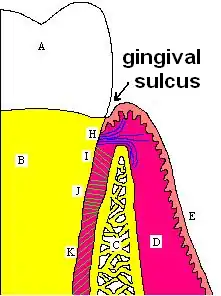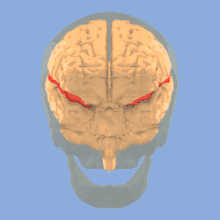Sulcus (morphology)



In biological morphology and anatomy, a sulcus (pl. sulci) is a furrow or fissure. It may be a groove in the surface of a limb or an organ, notably in the surface of the brain, but also in the lungs, certain muscles (including the heart), as well as in bones, and elsewhere. Many sulci are the product of a surface fold or junction, such as in the gums, where they fold around the neck of the tooth.
In invertebrate zoology, a sulcus is a fold, groove, or boundary, especially at the edges of sclerites or between segments.
In pollen a grain that is grooved by a sulcus is termed sulcate.
Examples in anatomy
- anterior interventricular sulcus
- calcaneal sulcus
- coronal sulcus
- femoral sulcus or intercondylar fossa of femur
- gingival sulcus
- gluteal sulcus
- interlabial sulci
- intermammary sulcus
- intertubercular sulcus, the groove between the lesser and greater tubercules of the humerus (bone of the upper arm)
- lacrimal sulcus (sulcus lacrimalis)
- malleolar sulcus
- patellar sulcus or intercondylar fossa of femur
- posterior interventricular sulcus
- preauricular sulcus
- radial sulcus (musculospiral groove)
- sagittal sulcus
- separatoral sulcus (depression behind the brow ridges of some primates)
- sigmoid sulcus
- sulcus arteriæ vertebralis
- sulcus subtarsalis in the eyelid
- sulcus tubae auditivae
- tympanic sulcus[1]
- urethral sulcus[2]
In neuroanatomy
In the brain a sulcus is a groove formed in the stage of gyrification by the folding of the cortex. There are many sulci and gyri formed. A larger than usual sulcus may instead be called a fissure such as the longitudinal fissure that separates the two hemispheres.
See also
- Fissure (anatomy)
- Sinus (botany)
- Sulcus sign
References
- ↑ "Tympanic sulcus". The Free Dictionary. Retrieved 2021-05-19.
- ↑ Larkins, Christine E., and Martin J. Cohn. "Phallus development in the turtle Trachemys scripta." Sexual Development 9.1 (2015): 34-42.